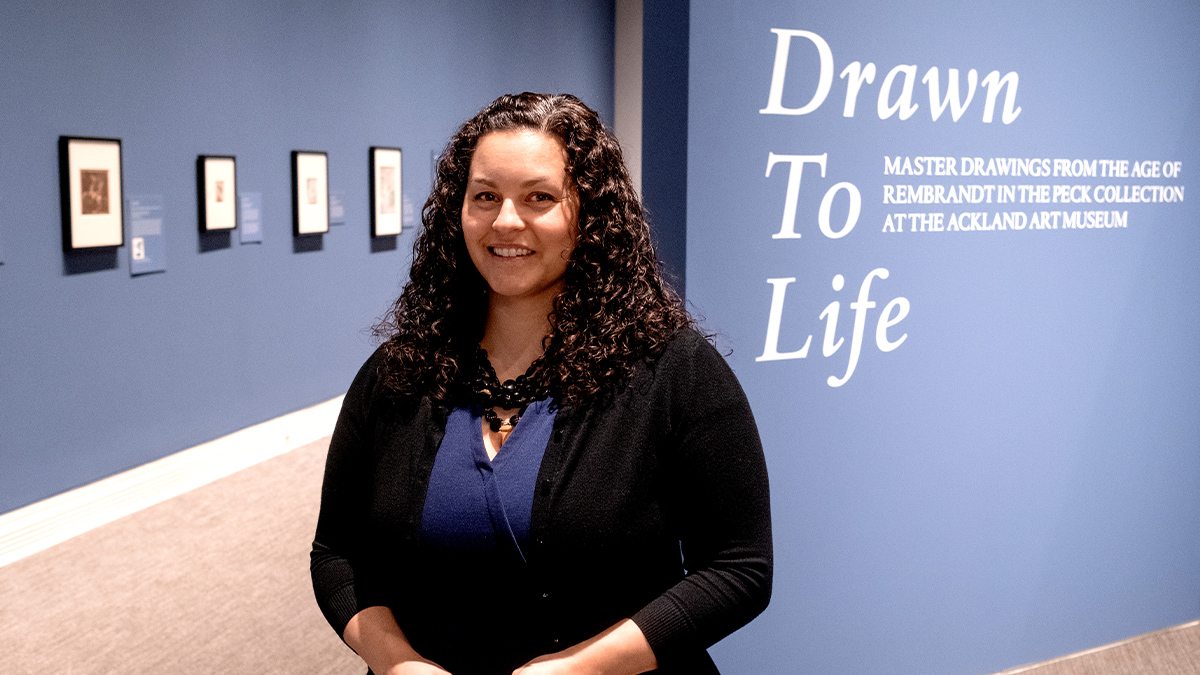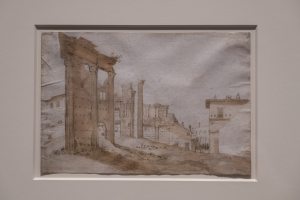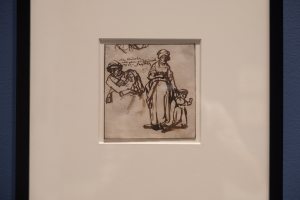Drawing is universal
A new exhibition at the Ackland Art Museum showcases rare and previously unseen drawings from Dutch masters, including the most celebrated artist of the era, Rembrandt van Rijn.

A collection of rarely exhibited drawings by the renowned Dutch master Rembrandt van Rijn and his contemporaries is on display at the Ackland Art Museum through Dec. 31
The exhibit, “Drawn to Life: Master Drawings from the Age of Rembrandt in the Peck Collection at the Ackland Art Museum,” includes over 70 drawings from the 17th century that mark a change in artistic vision during the time. In the drawings, which include landscapes, portraits, market scenes and more, the artists create images that highlight the beauty of the natural world, including its imperfections.
Dana Cowen, the Sheldon Peck Curator for European and American Art before 1950 at the Ackland, says this exhibit has mass appeal.
“Drawing is universal. We learn how to draw when we’re young, and everyone can draw, whether you’re a trained artist or not,” Cowen says. “When you look at these drawings, you will see things you recognize. This content is accessible and unpretentious, and everyone can find something they find interesting, funny or relatable.”
Cowen talks about how the Ackland acquired the valuable drawings, some highlights of the exhibition and why this will be the community’s only chance to see the drawings for many years.
How did the Ackland acquire this collection of drawings by Rembrandt and his contemporaries?
The drawings are from the Peck Collection, which was donated in 2017 by Dr. Sheldon Peck and his wife, Leena, both of whom have recently passed away. Peck was a double Tar Heel alumnus who became interested in collecting drawings after attending an event at Harvard University where a curator was showing Rembrandt drawings. Part of the talk was about connoisseurship and being able to discern a Rembrandt drawing from one of his students’ drawings. That activated the analytic aspect of Peck’s mind, a prominent orthodontist in the Boston area, who approached his study of the drawings with a level of thorough examination akin to the care of his patients.
Peck was a self-taught art historian who appreciated the Dutch masters’ natural depictions of humanity and everyday life. He chose to give the collection he spent 40 years amassing to the Ackland because, as an alumnus, he knew it would have a positive impact on students and make the museum one of the major centers for Dutch drawings in the United States.

“Ruins of the Temple of Minerva in the Forum of Nerva” was originally attributed to Cornelis Hendriksz. Vroom, but research in preparation for the exhibit revealed that Vroom was too young to have created the piece when it was drawn. (Jon Gardiner/UNC-Chapel Hill)
What can people expect to see at this exhibition?
These drawings depict landscapes, everyday life, portraits, preparatory studies and biblical and historical scenes drawn by well-known artists like Rembrandt van Rijn, Jacob van Ruisdael, Jan van Goyen, and Adriaen van Ostade as well as lesser-known, yet equally compelling, artists like Guillam Du Bois and Herman Naiwincx. These drawings contain everything from small sketches quickly scribbled from life to preparatory drawings that were used in well-known paintings to finished, autonomous drawings meant for the market.
Why is this exhibition notable?
We are displaying over 70 exceptional Dutch drawings from the 17th century, many previously unpublished and rarely exhibited. Rembrandt van Rijn, the most celebrated artist of this period, and his pupils represent a highlight of the exhibition. Following the end of its run at the Ackland on Dec. 31, “Drawn to Life” will travel to the Rembrandt House Museum in Amsterdam from March 18 to June 11, 2023. Since these drawings are sensitive to light and can only be displayed for short periods of time, this is the last time they will be displayed in a public exhibition for many, many years to come.

“Studies of Women and Children” by Rembrandt van Rijn is one of 17 surviving drawings with Rembrandt’s own writing on it. (Jon Gardiner/UNC-Chapel Hill)
What are some highlights of the exhibition that people should look for?
“Studies of Women and Children” is an example of Rembrandt observing his subject from life, capturing the figures’ essence and character with just a few strokes of his pen. It’s also one of only 17 drawings that survives today to bear Rembrandt’s own inscription on it.
“Studies of Putti” by Abraham Bloemaert is a dynamic drawing of nude babies, or putti, from early in the artist’s career. While preparing for the exhibition, our paper conservator, Grace White, removed a backing sheet attached to the drawing, which revealed drawings on the reverse that Bloemaert had made later in his life. Visitors can view both sides of the sheet in the exhibition.
“Ruins of the Temple of Minerva in the Forum of Nerva” is one of the last surviving drawings of the Temple of Minerva in Rome before it was largely destroyed in the seventeenth century. It was previously identified as the Temple of Venus Genetrix and attributed to Cornelius Vroom, but research conducted by our Peck Collection Research Fellow, Robert Fucci, determined Vroom would have only been 15 years old at the time and living in Haarlem. With this new information, we will be able to continue studying the work to determine its author.
How can people learn more about the works in the exhibition?
The Ackland is open five days a week, with tours scheduled throughout those days. Visitors can go through the exhibition on their own or join a tour with one of our guides. We also have a website that features the Peck Collection and an accompanying catalog of “Drawn to Life.” We have numerous events scheduled to celebrate the exhibition and to engage the community. Our upcoming ‘Acktoberfest’ on Oct. 14 will feature beer and cheese pairings related to some of the drawings, curator-led mini-tours of “Drawn to Life,” and a still-life drawing station. On Nov. 10, we are holding a lecture by renowned art historian Wayne Franits about 17th-century Dutch drawing, hosted by the UNC-Chapel Hill Department of Art and Art History and MEMS, UNC’s Medieval and Early Modern Studies Program, and on Nov. 12, 10-13-year-olds can sign up for an intro to drawing techniques class using works from the exhibition. We also have a cosponsored event with Carolina Public Humanities to read and discuss Nina Segal’s historic novel “The Anatomy Lesson” on Dec. 9.




